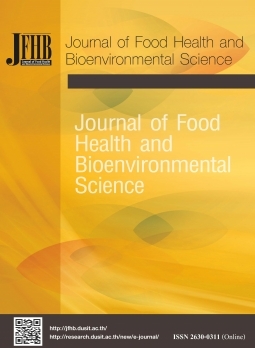Effects of Sangyod Rice as a Substitute for Wheat Flour on the Physical Properties of Butter Cake Products
Keywords:
Scanning electron microscopy, Texture profile analysis, Thai rice, Wheat flour substitutionAbstract
Sangyod is a native rice of Thailand and is used in many types of food owing to its high nutrient value. Indeed, it is used in bakery products to increase their nutritional value. In this study the effect of using Sangyod rice flour as a substitute for wheat flour in butter cakes was assessed. The physical properties of the butter cakes were produced using Sangyod rice flour 50%, 75% and 100% (by wheat flour weight). Increasing the amount of Sangyod rice flour resulted in a higher density batter and cake but lower specific volume. Scanning electron microscopy revealed that the microstructure of the butter cakes contained fewer air bubbles when the amount of Sangyod rice flour was increased, due to Sangyod rice not containing gluten, which traps air bubbles. Regarding the texture profile, the hardness and chewiness of the butter cakes were significantly higher when they were made with Sangyod rice rather than the control recipe (p ≤ 0.05). Furthermore, when the amount of Sangyod rice flour in the butter cakes was increased, the L* and b* values decreased and the a* value increased significantly (p ≤ 0.05).
References
A Cuisine. (2019). “Gold dessert” Many stories in the Thai dessert stand. Retrieved April 21, 202 2 from https://acuisineth.com/food-story
Anonymous. (2020). What is a Brix refractometer, and how do they work? Retrieved April 21, 2022 from https://www.instrumentchoice.com.au/news/what-is-a-brix-refractometer-and-how-do-they-work
Bureau of Nutrition, Department of Health, Ministry of Public Health. (2018). Food composition table of Thai foods. Retrieved April 22, 2022 from https://nutrition2.anamai.moph.go.th/th/thai-food-composition-table/download
Bureau of Nutrition, Department of Health, Ministry of Public Health. (2002). Fatty acids composition and cholesterol in Thai foods. Retrieved April 22, 2022 from https://nutrition2.anamai.moph.go.th/th/thai-food-compositiontable/download
Dholvitayakhun, A. (2013). Food experimental (2th ed.). Bangkok: Odeans store.
Ketthongkam, P. (2014). The production of simulated egg yolk for Thong Yoad (Thai dessert) (Master’s thesis). Bangkok: Kasetsart University.
Kyzlink, V. (1990). Principle of preservation. Amsterdam: Elsevier.
Mongkonworawan, K., Jangchud, K., & Wongtong, O. (2002). The effects of syrup concentertion on the qualities of Kha-nom Tongyod, Tongyib and Foytong. In The 40th Academic Conference of Kasetsart University (pp. 454-461).
Bangkok: Kasetsart University. Simons, C. (2022). Properties of water. Retrieved May 1, 2022 from https://cwsimons.com/properties-ofwater
Sinthawalai, S. (1982). Sugar. Retrieved May 1, 2022 from https://sites.google.com/sitexxyphuchsersthkic/khunsmbati-kayphaph-khxng-natal-thray
Suan Dusit Poll. (2021, 7 November). Thai dessert and Thaipeople, Suan Dusit University. Retrieved May 1, 2022 from https://suandusitpoll.dusit.ac.th
The chemistry of textiles, food and surroundings. (2016). The concentration level of syrup in making egg desserts or “Golden Desserts”. Retrieved May 1, 2022 from https://www.facebook.com/textile.phys.and.chem/photos/
Downloads
Published
How to Cite
Issue
Section
License

This work is licensed under a Creative Commons Attribution-NonCommercial-NoDerivatives 4.0 International License.








